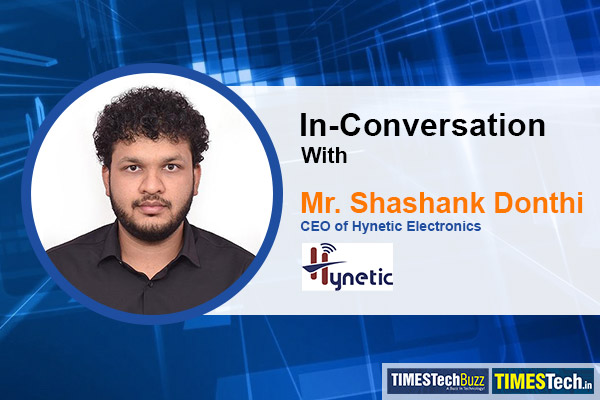Explore the dynamic journey of Hynetic Electronics, founded in 1989, as CEO Shashank Donthi discusses the company’s evolution from a semiconductor distributor to a global engineering design house. Discover how Hynetic’s commitment to sustainability drives innovations in smart lighting, energy management, and electric vehicles, positioning them as a key player in the green economy. Uncover the challenges and triumphs in the company’s expansion from India to international markets, showcasing their prowess in leveraging IoT expertise on a global scale.
Read the full interview here:
TimesTech: Can you share the story of Hynetic Electronics’ inception in 1989 and highlight key innovative products that contributed to its success in sustainable technology?
Mr. Shashank: Hynetic Electronics was founded in 1989 with a vision to become a demand creation distributor, quickly establishing a robust application engineering capability to aid the transition of designs from paper to product for Indian customers. This foundational strength enabled the company to leverage its engineering capabilities to pivot towards emerging technologies. Specifically, Hynetic focused on the Internet of Things (IoT) as a technology mandate to enable and empower distributed systems to harness renewable energy efficiently. The company carved out a niche in data concentrator solutions, which played a pivotal role in monitoring and managing large-scale deployments of solar and wind energy harvesting systems. Building on this specialization, Hynetic further refined its focus towards smart lighting solutions, aiming to improve operational efficiency and transition lighting infrastructure towards sustainability goals. This strategic direction underscored Hynetic’s commitment to innovation and sustainable technology, contributing significantly to its success in the field.
TimesTech: How has Hynetic Electronics actively contributed to technology supporting the green economy, especially in Smart Lighting and Energy Management?
Mr. Shashank: Hynetic Electronics has made significant contributions to the green economy, particularly in the realms of Smart Lighting and Energy Management by facilitating the adoption of LED technology. Hynetics smart lighting technology provides a 50% reduction in energy consumption compared to conventional systems. This effort has been supported by the development and deployment of large volumes of LED drivers by Hynetic, which are crucial for the transition towards more efficient lighting technologies. Hynetics IoT solutions are designed to monitor and manage critical lighting infrastructure in real time. This innovation enables precise control over lighting systems, further enhancing energy efficiency. Additionally, the integration of metering chips has allowed for the accurate monitoring of energy consumption, while the development of predictive maintenance algorithms supports the efficient management of infrastructure. These efforts underscore Hynetic Electronics’ commitment to advancing technologies that support the green economy, showcasing their role in promoting sustainable energy consumption and management practices.
TimesTech: Could you elaborate on Hynetic’s journey from a semiconductor distributor to an engineering design house and discuss key strategies in this evolution?
Mr. Shashank: While Hynetic Electronics was initially conceived as a demand creation distributor, the company established a strong foundation in application engineering which formed the basis for its transition into an engineering design house. This capability was instrumental in supporting the transition of designs from paper to product for Indian customers, bridging the gap between conceptual design and tangible technology. Hynetic leveraged its engineering prowess to pivot towards emerging technologies, recognizing the potential for growth and innovation in new areas.
The company’s journey took a significant turn as it shifted from merely supporting customer manufacturing through application engineering to providing comprehensive turnkey solutions under an ODM and white-label business model. This strategic move allowed Hynetic to take greater control over the intellectual property (IP) and quality of the products manufactured. Through this evolution, Hynetic Electronics not only enhanced its service offering but also positioned itself as a key player in the technology sector, adept at managing the complexities of product development and market demands.
TimesTech: current technological innovations align with Hynetic’s sustainability commitment, and are there specific projects showcasing the company’s dedication to innovation?
Mr. Shashank: Hynetic Electronics’ commitment to sustainability is strongly reflected in its current technological innovations, particularly in the electric vehicle (EV) sector. The company has strategically entered the burgeoning EV market, recognizing the critical role of sustainable transportation solutions in the global effort to reduce carbon emissions. This foray into EV solutions demonstrates Hynetic’s dedication to innovation and its alignment with environmental sustainability goals. Specifically, Hynetic has achieved notable successes in EV communication and charging technologies, securing a few design wins that underscore its capability and commitment in this area. These achievements highlight Hynetic’s efforts to contribute to the development of the EV ecosystem, offering cutting-edge solutions that support the transition to greener, more sustainable transportation options.
TimesTech: Outline Hynetic Electronics’ future sustainability goals and any specific targets or milestones in place to enhance its environmental impact.
Mr. Shashank: Hynetic Electronics is setting ambitious future sustainability goals, focusing on enhancing its environmental impact through strategic initiatives. The company is actively lobbying for the large-scale adoption of smart lighting technologies worldwide, aiming to significantly reduce the carbon footprint associated with conventional lighting solutions. This effort reflects a commitment to not only advancing technological innovation but also promoting environmental sustainability on a global scale. Furthermore, Hynetic is dedicated to supporting the adoption of electric vehicle (EV) technologies by designing and developing robust and economically viable solutions tailored to the emerging market.
TimesTech: Share the journey of Hynetic’s expansion from India to Singapore, highlighting challenges and opportunities. How does the company leverage IoT expertise on a global scale?
Mr. Shashank: Hynetic Electronics’ journey of expansion from India to international markets such as Singapore and Dubai mark a significant stride in its global outreach, particularly in the Southeast Asian (SEA) and Middle East and Africa (MEA) regions. This strategic move was aimed at supporting market expansion and tapping into new opportunities by leveraging its Internet of Things (IoT) expertise on a global scale. Hynetic provides customized and scalable IoT solutions to partners worldwide, enabling the effective penetration of its products into relevant markets.
However, this expansion journey has not been without challenges. The cost of adopting new technology, regulatory hurdles that vary by country and region, the capital required to sustain global expansion efforts, and the time needed for the adoption and deployment of complex projects involving multiple government bodies have all posed significant obstacles. Despite these challenges, Hynetic has identified substantial opportunities that lie in virgin markets with a high TAM and potential for the adoption of Hynetic products and technologies.
Hynetic has a proven track record of deploying its technology in prestigious projects within India. This, coupled with its ability to compete with the largest global lighting brands and win projects, underscores its strength and potential for further growth.















